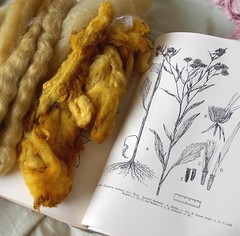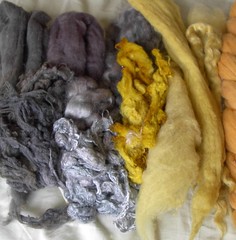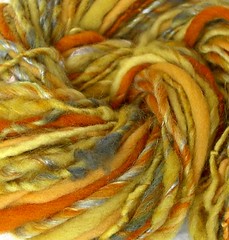
And I ended up pulling out my entire mini-stash of naturally dyed fibers that I've saved up over the past few months:



And combined them into a few new yarns!


I still have enough fiber for one more skein. Now I have plans to (attempt) to dye/spin a whole section of natural plant-dyed yarns and fibers for the fall Crafty Bastards show. I'm really picky about my natural dyes, which is why I've never offered naturally dyed stuff for sale before - all my dyes are either harvested by me (and I always plan my harvests around the plant's fertility, so that I never interrupt the breeding cycle, plus I never take more than the local population of that plant can recover from) or purchased from sustainable, ethical sources. A lot of dye plants are endangered in certain areas, so I find it very important to make sure I'm not wrecking native ecosystems. I also never use toxic mordants. I prefer to use natural plant mordants that I can collect myself or natural dyes that don't need mordants, but I do occasionally use alum. There are three different types of alum, some more toxic than others, but I usually use the alum that is used in food - you can read more here. I always save and re-use the water from mordanting fibers in alum, so it never gets dumped down the drain.
I also used some milkweed seed fluff in one of the above yarns, and I thought I'd give a quick mini-tutorial for anyone interested in collecting some. Milkweed grows pretty much everywhere on the east coast and the midwest - I'm not so sure about the rest of the country. Oh, and also someone commented on my last post and reminded me that some folks are allergic to milkweed...it oozes a sticky milky white liquid when cut or bruised (like dandelions), and it can be an irritant to some people. I've never had a problem, and I've actually eaten milkweed before (the young tops of the plant in early spring, the flowers, and the very immature seed pods are all edible, but I think the rest of the plant is not only inedible but toxic/poisonous). Here's a link with more info if you're curious.
Milkweed seed fluff is shiny and soft, but not strong at all. I experimented a lot with spinning it a few years ago, and it cannot be spun on it's own, even with multiple plies - the yarn will fall apart with a gentle tug. But it does make an interesting addition to other fibers, so if you have hand cards or a drum carder you can easily blend it into your yarns. Milkweed seed fluff has other uses besides spinning, too - it makes really good "down" jackets or pillows. Milkweed fluff is lighter, warmer, and more compact than goose down! There have been attempts to grow milkweed commercially as a down substitute, but so far it hasn't been successful since not all of the plants produced seed pods. There used to be a pattern for making your own winter jacket stuffed with milkweed down on eBay, but I haven't checked in a while.

So, on to the tutorial. I picked a few pods while hiking, because I wanted just enough fluff to blend into a skein of yarn. Some people wait until the pods are old and crack open on the plant to release the seeds, but I prefer to get them while they're still green because the fibers are damp and much less flyaway. The pods have a "seam" up the back, and if you press on either side of it, it opens easily.

Inside is a core surrounded by the seed fluff, with the seeds on the outside. These seeds are immature - they should be dark brown when mature. I usually save the seeds and scatter them outside near where I picked the pods, but these ones aren't ready. I hold the fibers down with one hand and gently scrape the seeds off with the other, leaving just the fibers still attatched to the core.

Once I've stripped all the seeds off, I carefully pull the seed fluff away from the inner core. I say carefully because the core is delicate, and if you pull too quickly or too hard you can pull off pieces of the core with the seed fluff. Once you're done, you should have a pile of seed fluff, a pile of seeds, the inner core, and the outer pod.

Repeat until you have enough fluff. The fluff is super flyaway when it dries. I like to store it in a closed paper bag so that air can circulate. If you have mature seeds, please consider scattering them in an area where milkweed grows so that there will be more plants next year!

5 comments:
Oh, thanks for this! I wonder if we have any here, in TN?
I'd love to hear more about collecting natural dyes and natural mordants!
I think so...I used to see it all over the place in NC when I was down there! Just google "common fleabane" and it should bring up pictures etc. It likes open areas, like abandoned fields, roadsides, and parking lots.
I was playing with madder root and logwood not so long ago- amazing stuff, it's like magic. Love the milkpod idea- they're one of my favorite parts of fall!
I was searching for naturally dyed spinning fiber and your entry came up - absolutely fabulous. Reading about your experiments is good fun, and of course educational! Thanks for your explorations. :)
those yarns are absolutely yummy! I can't wait to use milkweed next year.
Post a Comment